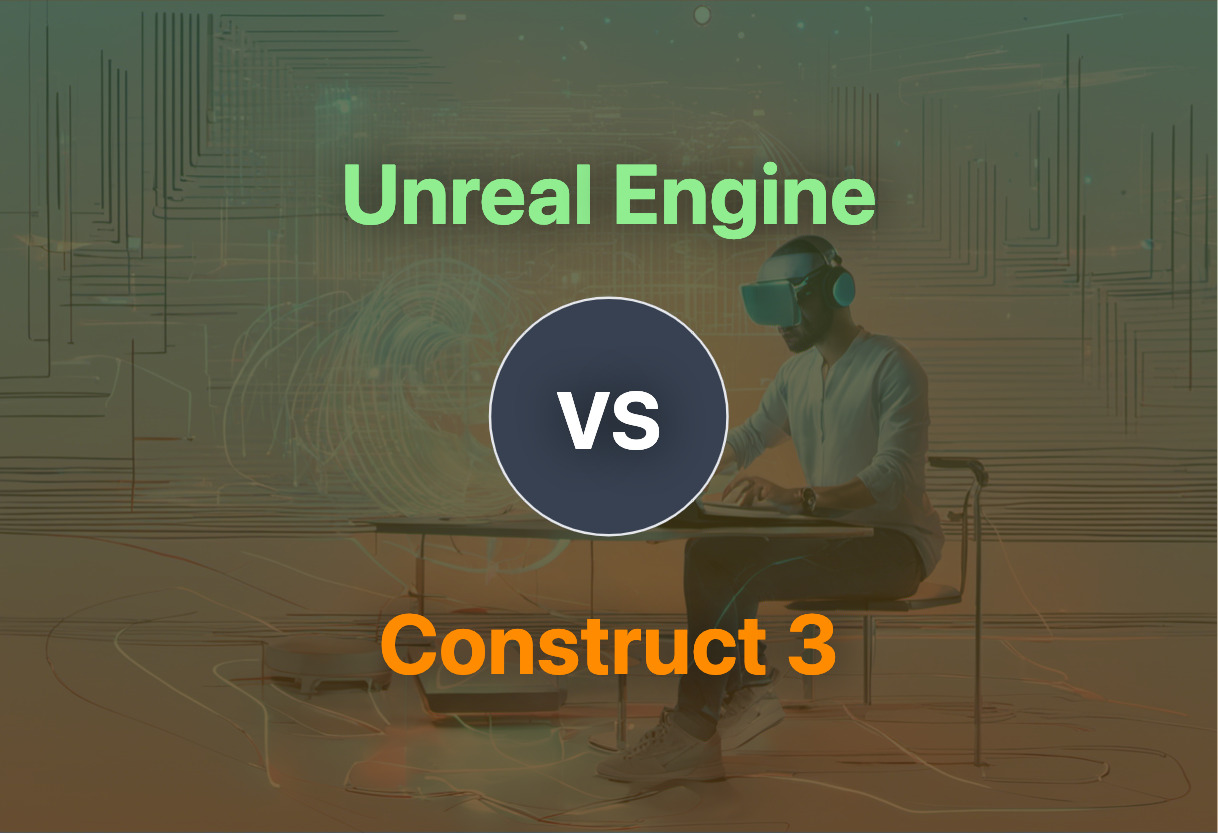For seasoned creators seeking 3D game design, interactive TV and film experiences, Unreal Engine dominates with its robust C++ framework and wide platform support. For beginners, educators, and indie developers focused on 2D game development, Construct 3‘s event sheet programming and HTML5 compatibility offer a swift, less complex entry into game creation.

Key Differences Between Unreal Engine and Construct 3
- Coding: Unreal Engine uses C++, Construct 3 employs event sheets, simplifying development for non-programmers.
- Dimension: Unreal Engine specializes in 3D projects, while Construct 3 is predominantly for 2D designs.
- Usage: Unreal Engine suits advanced developers; Construct 3 is tailored for beginners, educators, and indie developers.
- Pricing: Unreal Engine charges 5% revenue on products earning over $1M; Construct 3 adopts a subscription model, starting at $99/year.
- Platform: Unreal Engine supports wide array of platforms; Construct 3 is limited to web applications and playable ads.
| Comparison | Unreal Engine | Construct 3 |
|---|---|---|
| Initial Release | 1998 | 2007 as Construct Classic, Construct 3 Released in 2017 |
| Game Development | 3D game engine | 2D game engine |
| Primary Programming Language | C++ | Event Sheets, JavaScript as an optional |
| Latest Version | Unreal Engine 5, launched in April 2022 | Construct 3 with JavaScript integration added in May 2019 |
| Target Platform | Supports a wide range of platforms, including desktop, mobile, console, and virtual reality platforms | Primarily HTML5-based web applications, playable ads, and dedicated programs on any browser including Chromebooks. |
| Revenue Model | 5% of revenues over USD 1 million for commercial use. Royalty model waived for games published on the Epic Games Store | Free and Paid, starting at $99/year for the personal plan |
| Extra Features | Unreal Engine Marketplace for community content. Basic project templates for a first-person or third-person experience | In-built pixel editor for game graphics, compliance with data privacy regulations, focus on getting more students to master coding and game designing |
What Is Unreal Engine and Who’s It For?
Unreal Engine (UE), developed by Epic Games, is a top-tier 3D computer graphics game engine unveiled first in 1998. Originally crafted for PC’s fast-paced shooters, it later expanded its horizons to a wide array of game genres across various industries such as film and television. UE has several versions, with the latest being Unreal Engine 5 (UE5) launched in April 2022.
Prominently written in C++, the engine caters to a vast landscape, encompassing desktop, mobile, console, and VR platforms. It’s a favorite tool among professional game developers, modders, and even in educational institutions. Unreal Engine’s royalty model is favourable for indie developers, making it a preferred choice for diverse game development projects.

Pros of Unreal Engine
- Extensive platform support
- Advanced 3D graphics and tools
- Favorable royalty model
- Innovative level editor, UnrealEd
- Free for schools and universities
Cons of Unreal Engine
- High system requirements
- Can be complex for beginners to handle
- Learning curve involved for mastering C++
What Is Construct 3 and Who’s It For?
From the house of Scirra Ltd, Construct 3 burst into the tech scene as an HTML5-based 2D game engine. Primarily used for 2D game development, Construct 3 is favored by both novice enthusiasts and professional developers. With its intuitive ‘event sheets’ for visual programming, it streamlines game creation significantly.
This versatile tool offers extensive browser compatibility and even supports offline use. It has integrated pixel editor for game graphics, robust behaviors support, and is proficient for non-coding language based operations. It is ideal for educational institutions, indie game developers, and is known for being one of the most practical tools for 2D game development.

Pros of Construct 3
- Easy to learn for beginners
- Non-coding operations
- Comes with in-built pixel editor
- Offers a cost-effective subscription plan
- Compliant with data privacy regulations
Cons of Construct 3
- Challenge creating large-sized games
- 2D focused, limiting 3D game development
- Depends on device’s support for web content for successful exporting
- Doesn’t support offline application behavior
Unreal Engine vs Construct 3: Pricing
When compared, Unreal Engine adopts a revenue-sharing model while Construct 3 charges an annual subscription fee for usage.
Unreal Engine
Epic Games, the developer of Unreal Engine, charges 5% of revenues over $1 million for commercial use of the engine. This royalty model is waived if the games are published on the Epic Games Store. Unreal Engine 4 is free for all users, but a 5% revenue charge is imposed for products making over $3,000 per quarter. Moreover, Epic rewards the content creators of the Marketplace with 88% share of the revenue generated. For educational institutions, Unreal Engine is free to use.
Construct 3
Scirra Ltd, the developer of Construct 3, offers both a free version of the engine and a paid subscription with extended features. The starting price for the paid version is $99 per year under the personal plan.
Sure. Let’s explore examples for Unreal Engine and Construct 3, where the objective is creating an AI character that moves between checkpoints in a loop. These are simple, yet exciting, tasks in gaming particularly appealing to beginner and intermediate programmers. “`html
Code Examples for Unreal Engine & Construct 3
Unreal Engine
This simple Unreal Engine 4 script creates an AI character that moves between checkpoint actors placed in the level. To do this, the script uses the UE4 AI MoveTo function, which moves the Actor towards the target actor. Make sure to set up the navigation mesh and place your checkpoints in the level beforehand.
// Unreal Engine C++ AI move to checkpoint
void AMyAIController::MoveToNextCheckpoint()
{
if (CurrentCheckpoint != nullptr)
{
MoveToActor(CurrentCheckpoint, 5.0f);
CurrentCheckpoint = CurrentCheckpoint->NextCheckpoint;
}
}Construct 3
This Construct 3 code snippet produces similar results as the previous. It moves a sprite towards a number of waypoints on the screen in a loop. Checkpoints could be any sprite objects placed in the game world, and the Sprite object needs a Pathfinding behavior which you can easily add using the Construct 3 editor.
// Construct 3 JavaScript move to checkpoint
var waypoints = [checkpoint1, checkpoint2, checkpoint3];
var currentWaypoint = 0;
function update() {
var distance = sprite.distanceTo(waypoints[currentWaypoint]);
if(distance < 5) {
currentWaypoint++;
if(currentWaypoint >= waypoints.length) {
currentWaypoint = 0;
}
}
else {
sprite.moveTo(waypoints[currentWaypoint].x, waypoints[currentWaypoint].y);
}
}“` These snippets provide scripting foundations to get started with AI movement in both Unreal Engine and Construct 3. It’s certainly a fun exercise to set up your own virtual waypoints and watch as your AI character navigates through them.
The Verdict: Unreal Engine or Construct 3?
Unreal Engine and Construct 3. Two powerful tools, each owning its unique arena. So, which leads the way?
Developers Beginning in Game Development
Construct 3 wins this round. It’s perfect for novices diving into game development. It’s user-friendly, easy to grasp, and ideal for simple 2D games. Simplified event sheets replace complex coding, plus Construct 3 can run on any browser. The offline accessibility feature is another bonus.

Professional Developers – Complex Game Development
Unreal Engine steals the thunder. If you’re venturing into the depths of complex game development, UE stands supremely adequate. It’s versatile, with expansive 3D capabilities, ultra-realistic graphics and real-time constructive solid geometry operations.

Developers Creating Large-scale Games
Again, Unreal Engine prevails. If you aim at large-sized games, UE is your reliable partner. Construct 3 has limitations with large scale game creation, hence UE claims the victory here.

Educational Institutions
Construct 3 comes out ahead. It’s a preferred choice in schools, thanks to its ease-of-use in teaching coding and game design. Being compliant with data privacy regulations, Construct 3 is indeed an educator’s friendly tool.

In a nutshell, if you’re a non-coder aiming at quick 2D game creation, Construct 3 is your go-to tool. But, when it comes to advanced, 3D, or large-scale game projects, Unreal Engine reigns supreme.
Tiffany Brise
Content writer @ Aircada, patiently awaiting a consumer AR headset that doesn’t suck.





